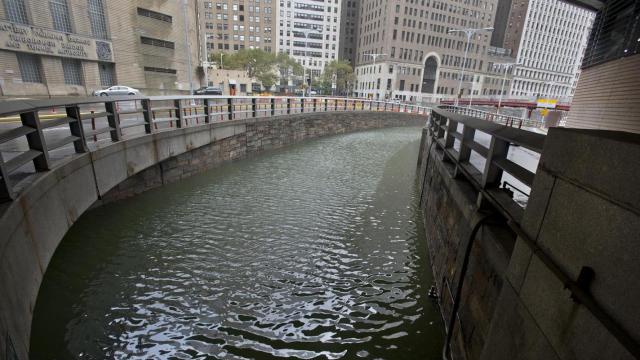If you’re planning to live in the Big Apple for the foreseeable future, it’s time to invest in flood insurance and a gondola. A new study finds that 2.7m floods, like those produced by Hurricane Sandy, will be three to 17 times more frequent by the end of the century, thanks to sea level rise and shifting storm conditions.
The Brooklyn-Battery Tunnel in the immediate aftermath of Hurricane Sandy in 2012. Image: New York MTA
Ever since Hurricane Sandy flooded the New York City subway, brought a record 3.35m storm surge to the Battery tide gauge and caused billions of dollars of property damage, scientists have been trying to understand just how extreme this disaster was in a historical context. Through detailed sea level reconstructions from 850 to 1850 AD, we’ve learned that Manhattan’s flood risk has indeed been going up steadily over the last millennia. The land is slowly sinking into the ocean, causing relative sea levels to rise at about 1.4mm each year.
But then came the 20th century, and a ramping up of sea level rise to around 3mm per year due to human-caused climate change. “We found that if you factor in this change in sea level that’s happened in New York [since the 19th century] that’s led to about a three fold increase in flood risk,” said Robert Kopp, an Earth scientist at Rutgers University and co-author on the new study.
Overall, Kopp says, a Sandy-like flood jumped from being a one-in-1200 year event at the dawn of the Industrial Revolution, to a one-in-400 year event in the year 2000.
That’s bad news, but it gets much worse when you look at changing flood risks over the 21st century. Our best models estimate that New York City will see half a metre to a metre of sea level rise by the end of the 21st century, thanks to ongoing subsidence of the land, melting ice sheets and the expansion of seawater as it warms up. Meanwhile, climate change is likely to have complex effects on storm dynamics, with the expectation that a warmer future will promote the growth of more powerful storms that can hold more rain.
Combining models of future sea level rise, shifting storm patterns and carbon emissions — which are assumed to follow the UN’s middle-of-the-road, RCP 4.5 scenario — Kopp and his colleagues estimated that Sandy-like floods will become about four times as frequent by the late 21st century. In other words, a once every 400 year event will become a one-in-100 year event. But there’s still a lot of uncertainty, particularly depending on which storm model you look at. In a worst-case projection, 2.7m floods could make a dramatic, 17-fold jump in frequency, recurring every 23 years on average by the end of the century.
“The grand answer is that things are going to get worse by 2100,” study co-author Ben Horton said in a statement.
For Kopp, the point of studies like this is not to terrify the bejeezus out of people, but to highlight the fact that we live in a rapidly changing world when it comes to flood risk. In New York, the risk is almost certainly going up, and that’s a reality which needs to be factored into all future planning decisions.
The same could be said for Miami, New Orleans, or any other major population centre on the front lines of sea level rise. And by the way, the world’s coastal populations are growing fast.
“The punch line is that this basically needs to be a core part of how we make decisions about anything that will be around for years to come,” Kopp said.
